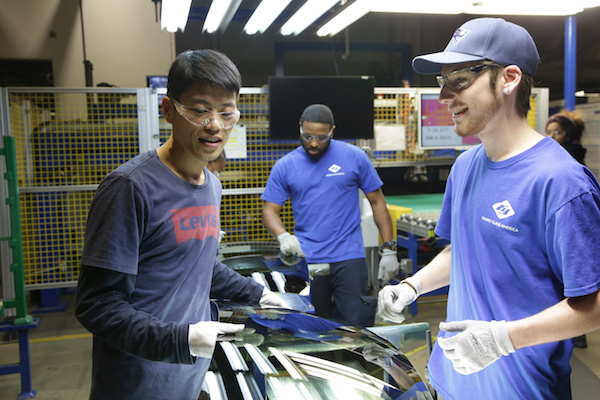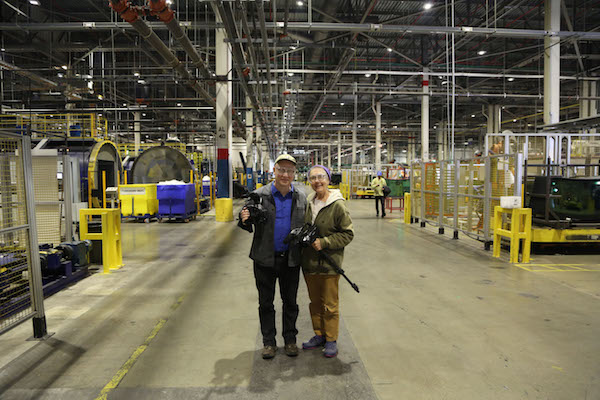
The documentary American Factory shows what happens when a former GM plant near Dayton, Ohio, is converted into an automotive glassmaking facility. Some 200 Chinese workers were imported to train approximately 2000 Americans at what became known as Fuyao Glass America. Co-directors Steven Bognar and Julia Reichert filmed throughout the factory over several months. With full access to both management and workers, they were able to provide an unusually detailed look at a world that’s almost never shown on screen.
Financed in part by Higher Ground, a production company founded by the Obamas, the film is nominated for an Academy Award for Best Feature Documentary. It is currently screening on Netflix.
I spoke with the co-directors by telephone on January 30 for an article that originally appeared in the South China Morning Post on February 3. Below are portions that for space reasons did not make it into SCMP.
Can you talk about how you started the project?
Julia Reichert: We made a film called The Last Truck: Closing of a General Motors Plant, in that very same plant in 2008. We knew what losses the workers there had experienced. They lost not only their jobs, they lost their pride, their homes, their cars, their hope, their sense of a secure life. We actually thought we would never be back in that plant. It stood empty, rusting, raccoons living in it. Some of the city fathers came to us and said, “Hey wouldn’t it be great if there were a film about the rebirth of the plant?”
Steven Bognar: We were interested, but their original idea was that they would hire us to make a film, and Julia and I said, Well, we don’t do that kind of thing. But if you give us real access and we own the film, we have editorial control over the film, we take zero money from the company, then we would do it.
Were you surprised when Cao Dewang, the founder and CEO of Fuyao, allowed you to film there?
SB: To our understanding he watched our earlier film, The Last Truck, and he said let’s do it. In the early days there was such genuine excitement, genuine hope, that this would be a really exciting, positive experience for everybody involved. But things got harder and tougher. As things got tougher, the chairman never withdrew his permission. He could have kicked us out of that factory at any time. As people started to get frustrated with each other, as people were saying things that weren’t flattering, whether they were Chinese or American, the chairman could have said okay, film crew, time to pack it up. But he never did. We’re grateful that he held to his commitment.

You spoke about “respecting the workers” when you filmed them. How do you do that?
SB: When you want to make someone look more like a movie star, you use a telephoto lens. Not like a ridiculously telephoto lens, but a longer lens.
JR: And you really want to watch the lighting. You want to get them bathed in really good-looking light. Luckily in a glass factory, light is all around, there are huge banks of light because they’re inspecting the glass. That was a great advantage to us. When we first walked in that factory, we were bowled over by the beauty that we saw there.
There are many scenes in Mandarin. Do you speak the language?
SB: No, neither Julia nor I speak Mandarin. We’re not Chinese, and our main camerapeople are not Chinese. We had a lot of translation work to do on this film, and we had a big team of translators. We just wanted to make sure the translations were accurate. Chinese is a very nuanced language. You can say different things with your intonations. Every line in the film is translated by different translators and then we had a cross-checking system to make sure it was accurate.
It’s fascinating what you filmed without realizing how insightful it was.
SB: It should be said that we filmed over 1,200 hours of material. So we had plenty of meetings and conversations that are very boring, that don’t help tell the story. We had a brilliant editor in our Lindsay Utz, a very gifted documentary editor. She shaped the 1200 hours into the movie.
American viewers may be tempted to see the Chinese as villains taking away their jobs.
JR: You know, we lost a lot of jobs that went overseas. Since the 70s and 80s, America’s sense of the future for working class people is diminished. People feel they’re losing ground compared to the Chinese. We’re on different trajectories. But if you look at it historically, it’s not like the Chinese are out to get us.
As countries, we’re in different stages in history. These last few years since we made the film, since the trade wars and tariffs, you have to see what’s happening in the context of the history of each country. The tectonic plates in the world are shifting. No question about it, China is taking a much more prominent role around the world, in Europe, the Middle East, Africa certainly. The kind of role the US used to take. But conditions for their workers are bad. In many ways it’s like working conditions in the U.S. sixty, seventy years ago, before there were unions.
But workers in China feel their own pressures from neighboring countries.
SB: The chairman told us he was worried that China, with its vast success, was going to drift into becoming a service economy, and that manufacturing and industrial jobs would go to Vietnam or other countries. China would lose its edge. As a manufacturer, he would argue that real wealth comes from making stuff and exporting it.
At the end of American Factory you address automation, which must be equally frightening to Chinese and American workers.
SB: Yeah, it’s a real issue. Automation is going to put hundreds of millions of people out of work.
JR: It depends on what we as a country decide to do about automation. To me, it’s not a bad thing for people to not break their backs in repetitive stress injuries. That’s not a bad thing. What would be a bad thing is if we as a country don’t do anything to support those folks who are losing those jobs. Most developed countries in western Europe devote a certain amount of their GDP, gross domestic product, to train workers for new kinds of jobs. We in the US, we’re at the bottom of the barrel in terms of the percentage of GDP we assign for training.
So I have a different take on automation. I don’t think we should see it as all these people are going to be on the dole or out on the street. That could be the outcome if we don’t do anything about as a country. We should talk to our officials about what they what they plan to do about AI, automation, and the new work force. It has to be on the national agenda.
Photos courtesy Netflix.


